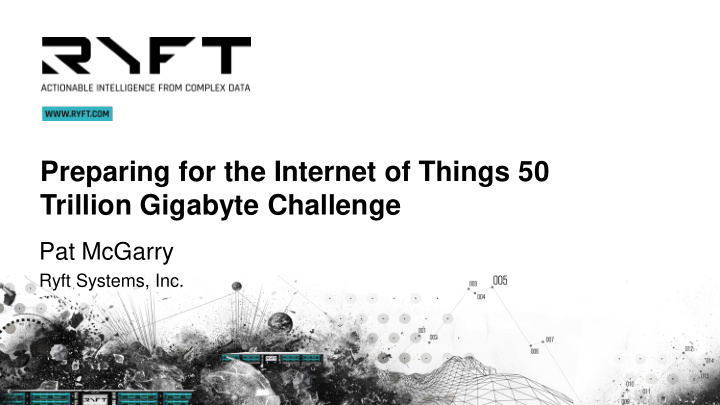



Preparing for the Internet of Things 50 Trillion Gigabyte Challenge Pat McGarry Ryft Systems, Inc.
The IoT 50 Trillion GB Challenge: The Largest Opportunity & Threat Since the Internet SOURCE: WIKIBON BIG DATA VENDOR REVENUE & MARKET FORECAST 2011-2026
Data Dynamics: Critical Differences in IoT Data What You Need to Know About IoT Data and Its Impact on Information Infrastructure Variety: an explosion of types and formats Structure: unstructured and messy Volume: too much for most platforms to analyze Velocity: fast and furious Value: expires quickly Location: widely distributed
Common Barriers to IoT’s Popular Use Cases WHAT ENTERPRISES NEED TO THRIVE WHAT ENTERPRISES HAVE TODAY Real-time insights as events occur, close to Analysis slowed by data ETL & the source of data movement Advanced-scale performance & storage to Persistent compute, I/O & storage analyze data from a variety of IoT devices bottlenecks Compact & efficient infrastructure Data types that must be analyzed in silos Easy to deploy, use & maintain Sprawling, inefficient analytics ecosystems infrastructures Minimal disruption to existing ecosystems Frequent software ecosystem updates Low operational costs Persistent data privacy & security issues No security or performance trade-offs
The Heart of Popular IoT Use Cases Real-time Image Recognition Optical Character Recognition Fraud Detection Similarity Search Biometric Recognition Financial Compliance Voice Recognition Malicious Pattern Matching Behavior Monitoring Cyber Security
Thriving in the IoT Era: Fast Data Analysis Powered by New Hybrid FPGA/x86 Compute Architectures “Systems built on GPUs and FPGAs will function more like human brains that are particularly suited to be applied to deep learning and other pattern-matching algorithms that smart machines use. FPGA-based architecture will allow further distribution of algorithms into smaller form factors , with considerably less electrical power in the device mesh, thus allowing advanced machine learning capabilities to be proliferated into the tiniest IoT endpoints, such as homes, cars, wristwatches and even human beings. — David Cearley, Gartner “Intel’s $16.7 Billion “Microsoft Supercharges Bing Search with Programmable Chips.” Altera Deal Is Fueled by Data Centers.”
Hybrid Compute: The Right Engine for the Job CPU GPU FPGA General purpose Some general purpose Not general purpose — Purpose built algorithms computing computing — Can be reprogrammed via firmware Sequential in nature Excels at Nondeterministic mathematically Data analysis — Search, fuzzy search, image and performance complex algorithms — Interrupts Image rendering, some video analysis, deep learning — Memory allocation image analysis Inherently parallel — Can execute many hardware- Problems broken Generally more parallel into sequential than CPUs, since parallel operations in one clock cycle — More output with less power operations & GPUs have more cores — Can complete the same problem at processed serially Generally more power efficient than CPU 100X the performance of x86/CPU
Requirements for Success: Compute-agnostic API Performance CPU GPU FPGA CPU GPU FPGA Open API
The Future Is Intelligence at the Network Edge Find the right data – even when it’s incomplete– whenever & wherever you need it. EDGE NODE EDGE NODE EDGE NODE
Questions? Visit the Ryft IoT SLAM booth Pat McGarry pat.mcgarry@ryft.com www.ryft.com
Recommend
More recommend